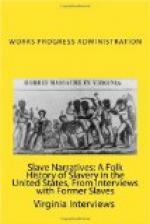Masters
“My parents’ master was named Wade. When he died, I was so little that they had to lift me up to let me see into the coffin so I could look at him. I went to his daughter. My name is after my father’s father. My grandfather was named Miller. I took his name. He was a white man.
“Wade’s daughter was named Riley, but I keep my grandfather’s name. My mother and father were then transferred to the Rileys too, and they took the name of Riley. It was after freedom that I took the name Miller from my original people. Haven Riley’s father was my brother.” (Haven Riley lives in Little Rock and was formerly an instructor at Philander Smith College. Now he is a public stenographer and a private teacher.)
“Wade owned all of my brothers and sisters and parents and some of my kin—father’s sister and brother. There might have been some more I can’t remember. Wade was a farmer.
“I remember once when my mother and father were going to the field to work, I went with them as usual. That was before Wade died and his daughter drew us.
“My wife died six years ago. If she had lived till tomorrow, she would have been married to me sixty years. She died on the tenth of February and we were married on the sixth. We just lacked five years of being married sixty years when she died.
Food
“For food, I don’t know anything more than bread and meat. Meal, meat, molasses were the only rations I saw. In those times the white people had what was known as the white people’s house and then what was known as nigger quarters. The children that weren’t big enough to work were fed at the white people’s house. We got milk and mush for breakfast. When they boiled cabbage we got bread and pot-liquor. For supper we got milk and bread. They had cows and the children were fed mostly on milk and mush or milk and bread. We used to bake a corn cake in the ashes, ash cake, and put it in the milk.
“The chickens used to lay out in the barn. If we children would find the nests and bring the eggs in our missis would give us a biscuit, and we always got biscuits for Christmas.
Houses in the Negro Quarters
“In the nigger quarters there were nothing but log houses. I don’t remember any house other than a log house. They’d just go out in the woods and get logs and put up a log house. Put dirt and mud or clay in the cracks to seal it. Notch the logs in the end to hitch them at corners. Nailed planks at the end of the logs to make a door frame.
“My people all ate and cooked and lived in the same room. Some of the slaves had dirt floors and some of them had plank floors.
“Food was kept in the house in a sort of box or chest, built in the wall sometimes. Mostly it was kept on the table.




